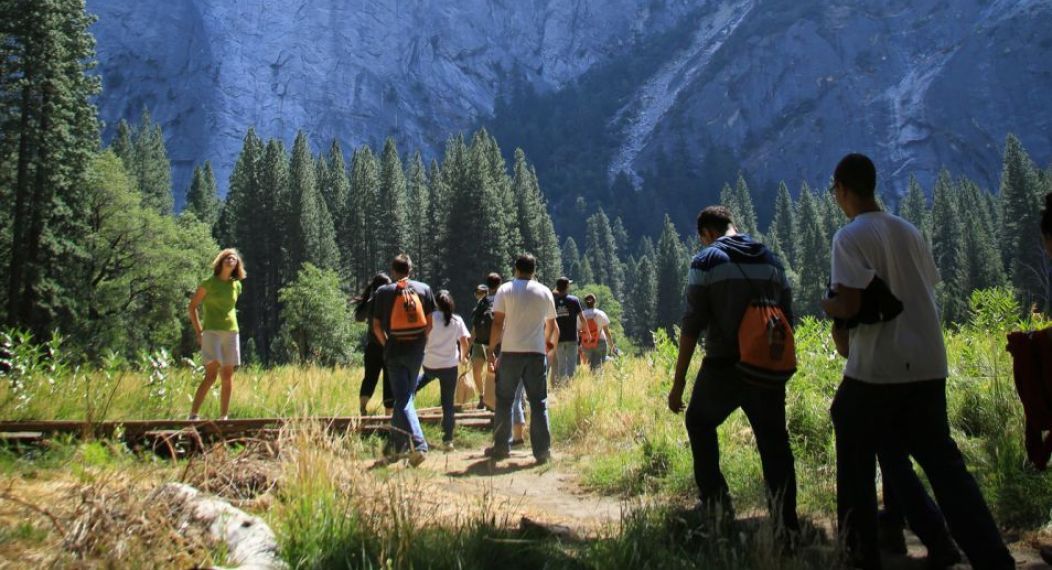Join us for explorations and discussions of the natural wonders of the west. Participants will complete coursework through email as well as participate in an excursion to each locale to see the geology, plants, and animals firsthand. You must attend the trip to receive credit for the course. These courses will be useful to anyone teaching natural sciences — most of the California State Earth Science Standards are covered. Those with a general interest in and appreciation for our National Parks and wild places are also welcome!
Sequoia and Kings Canyon National Parks are the home of awe-inspiring geological features and resources. The parks contain a significant portion of America’s longest mountain range, the Sierra Nevada. Included in the Parks’ mountainous landscape is the tallest mountain in the contiguous United States, Mt. Whitney, which rises to 14,491 feet above sea level. Eleven additional peaks taller than 14,000 feet are also found along the parks’ eastern boundaries at the crest of the Sierra Nevada. This course will include discussions of the origins, uplift, and sculpting of the Kings Canyon landscape. The geologic history of the 400 mile long Sierra Nevada mountain range will be discussed along with the many glacial features responsible for the Kings Canyon scenery. Other discussion topics will include plant and animal adaptations and Native American history.
Date: Oct. 21 - 22, 2023
Course Code: PEDD 9617
Anza-Borrego State Park is the largest state park in California. At 600,000 acres, it includes ecosystems of the Colorado Desert and the Peninsular Mountain Range. The region is one of the most active seismic area in North America. The Salton Trough contains two of the three major plate boundaries. The northern end of the East Pacific rise, a diverging plate boundary, is responsible for the -280-foot elevation at the bottom of the Salton Trough, second only to Death Valley. The second boundary type is represented by the San Andreas Transform fault system. The plate interaction here has exposed rocks from 1.5 billion years old to recent sediments 2 million years old. Our field trip will explore volcanism and rifting, granitic intrusions and metamorphism, faults, folds and badlands.
Date: Nov. 4 - 5, 2023
Course Code: PEDD 9600
The rock formations of Joshua Tree National park are not only visually stunning but also offer insight into the 1.7 billion year history of this spectacular National Park. This course will enable us to piece together the history of this region and much of California and the western US. Topics will include plate tectonics, climate and weather, rock identification, plant and animal adaptations and the interaction of life, land and climate. We will also take an excursion to surface ruptures of the 1992 Landers Earthquake. This 7.3 magnitude quake is one of the largest in California’s recorded history.
Date: Dec. 2 - 3, 2023
Course Code: PEDD 9601
On October 31st, 1994 Death Valley was designated a National Park. With 3.3 million acres it is the largest National Park in the contiguous United States. It includes the lowest point in the western hemisphere (282 feet below sea level) and, in 1913, an air temperature of 134 degrees F was recorded. This land of extremes offers a fascinating look at plant and animal adaptive strategies, faulting, volcanism, and human history. On-line presentations will be followed by a field trip to Death Valley.
Date: Jan. 20 - 21, 2024
Course Code: PEDD 9612
This 2-day field trip will explore the Southern California Coast from Newport to San Onofre State Beach. Day 1 stops will include the Muth Interpretive Center at Newport Back Bay, Crystal Cove State Park and Aliso Beach in Laguna. Day 2 stops are Dana Point, San Clement State Beach and San Onofre State Beach. We will discuss local geology, beach processes and adaptation of intertidal plants and animals.
Date: Feb. 10 - 11, 2024
Course Code: PEDD 9646
This class will cover plate tectonics, geologic time, basic rock types, and the structure and behavior of faults. Features associated with faults will be discussed and then observed on a 2 day field trip along the San Andreas Fault.
Date: Mar. 9 - 10, 2024
Code: PEDD 9611
This class will explore the geology and natural history of California’s Central Coast. The field study will take us as far north as Julia Pfeiffer Burns State Park on the Big Sur Coast and south to Morro Rock. We will discuss the geologic history of the rugged Big Sur Coast, the origin of Morro Rock, and the formation of Coast Ranges. Discussions will also include the components of the Coast Redwood forest ecosystem and the role of fire and introduced species. California’s cross section is a textbook example of an oceanic –continental subduction zone. We will see ophiolite sequences that represent the scraping off of the Farallon Plate as it subducted beneath the North American Plate during the formation of the Sierra Nevada Mountains. We will also see some to the most beautiful and rugged coastline in the world.
Date: Apr. 27 - 28, 2024
Code: PEDD 9603
Join us for a natural history tour of the Claremont Wilderness Park and the San Antonio Canyon. This course covers geology and plant communities of the Eastern San Gabriel Mountains. We will identify the major plants of the chaparral and riparian plant communities, discuss plant adaptations to the Southern California climate and explore how plants have adapted to chaparral fires. In addition we will see 1.7 billion year old rocks, debris fans and the Cucamonga thrust fault. We will view and discuss the major faults of San Antonio Canyon, see some of the oldest rocks in California, observe huge landslides and end up at a beautiful waterfall. Our drive will take us up in elevation about 5,500 feet through 5 biotic communities: Coastal Sage Scrub, Chaparral, Riparian, Yellow Pine Forest, and White Fir Forest. Our discussion will include plant adaptations to changes in elevation and names of the major plants in each community.
Date: May 18 - 19, 2024
Code: PEDD 9609
We will car caravan the length of Owens Valley from Fossil Falls in the south to the Bishop area in the north. The geologic history of the Owens Valley will be discussed while viewing rocks as young as 10,000 years and as old as 500 million years. On Day 1 we will visit Fossil Falls and see sculpted basalt worn smooth by glacial melt water during the Pleistocene Epoch. We will stop at Owens Lake and discuss its natural and man-made history. We’ll visit the scarp of the 1872 Lone Pine earthquake, an estimated 8 magnitude, one of the largest in California recorded history. Our last stop on Day 1 will be the basalt flows of the Big Pine Volcanic Field, just south of Big Pine. Day 2 will include a look at some 500-million-year-old rocks – the Poleta Folds and 5,000-year-old trees – the Bristlecone Pines of the White Mountains. Our last stops will be in Round Valley, just west of Bishop. We will visit the Buttermilk Boulders and the Pine Creek moraine.
Date: June 17 - 18, 2024
Code: PEDD 9643
Class Requirements
- View a Power Point presentation
- Attend a two-day field trip
- Students are responsible for lodging, food and transportation
- Field trips begin at 9 a.m. and end between 4 p.m. and 5 p.m.
- We car caravan from stop to stop
- Walks are usually one to three miles round trip
- Participants should be in reasonably good physical shape
- Field trip gear list:
- clothing appropriate for weather
- lunch, water, paper, pen, camera
- Submit a field trip report
- Submit to Instructor Ted Reeves tedpzmz@gmail.com
- The report is due one week after the end of the trip
- Field Trip Report must include:
- information and photos from each stop
- further on-line research on major topics
- report should represent about 8 hours of work
- the format can be Word, Pages, Power Point, Keynote
- Vehicles should be in good mechanical condition and arrive with a full tank of gas on the first day
Additional Information
- Each class is worth 3 semester units.
- Class tuition is $300. Non-credit tuition is $50.
- These courses are designed to meet professional development needs of educators for career and salary advancement and is not applicable to a degree at University of the Pacific.
- District approval is recommended before enrolling. An official transcript is available from Pacific upon successful completion of coursework.
- All field trip participants must register for the class. Non-credit tuition is $50.
- At any activities or events sponsored by this program, the University does not provide insurance coverage for non-registered students. The University does not sponsor, sanction, or cover non-registered students for any purpose.
Benerd College believes in making education accessible and meeting learners where they are at. Also, we are passionate about being a trusted and agile community partner. Here are a few ways to engage with us.




